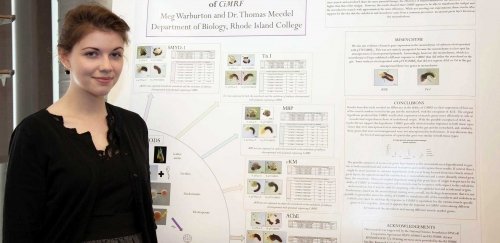
RIC biology major Megan Warburton
In an independent research project, honors biology major Megan Warburton ’15 experimented with a gene called CiMRF (Ciona intestinalis Myogenic Regulatory Factor), which plays a critical role in muscle development. The goal of her project was to test the effects of CiMRF using sea squirts as specimens. At a RIC poster session attended by faculty, administrators and students, Warburton shared the results of her research.
She said, “I wanted to determine if CiMRF was able to express muscle markers if CiMRF was injected into non-muscle tissue in sea squirts.”
First she gathered adult sea squirts, otherwise known as Ciona intestinalis, clinging to the dock at the Snug Harbor Marina in Wakefield. She took specimens back to RIC’s lab, removed the egg and sperm ducts from the males and females, fertilized the eggs and created larvae.
Injections of CiMRF were deposited into two different non-muscle tissue for comparison – the mesoderm (the middle germ layer) and the endoderm (the innermost germ layer). Warburton found that muscle markers recognized CiMRF and appeared in the endoderm and mesoderm.
“I was able to determine that there were similar levels of mis-expression between the two tissue types. This allowed me to conclude that CiMRF behaves similarly in the notochord [made up of cells derived from the mesoderm] and the endoderm.”
Warburton said that her study “will increase the literature that suggests an ancient germ layer known as mesendoderm, a precursor to the endoderm and mesoderm lineages, exists.”
She added that studies such as this one are important because they help us understand how organisms develop and what our tissue types are able to do.
Her research project, titled “Endoderm versus Mesoderm? Examining the Transformation Abilities of CiMRF,” was one of 19 thought-provoking, independent research projects conducted by graduating seniors in the College Honors Program and by members of the Rhode Island College Chapter of Sigma Xi (the Scientific Research Society).
Secretary of the Scientific Research Society, RIC Professor James Magyar, noted that “poster sessions are an important way for students to share their research with others. They gain the experience of organizing the experiments and results, preparing a poster and explaining their work to a friendly audience. The poster session is also a chance for faculty and academic leaders at the college to learn more about the work that is going on here.”
Warburton intends to enter the field of animal rehabilitation.
